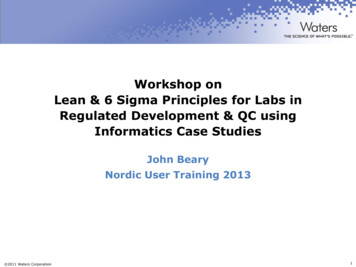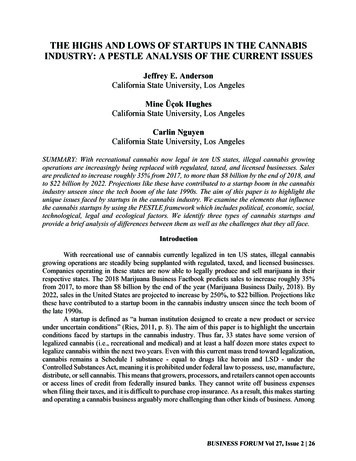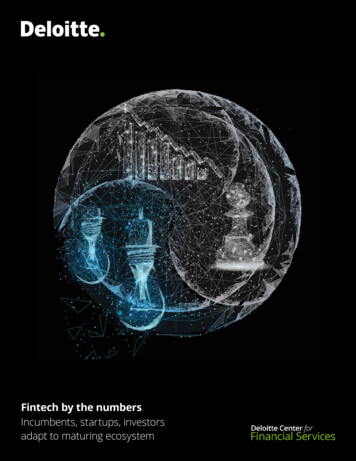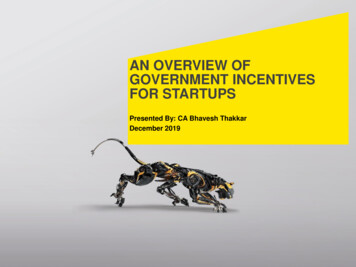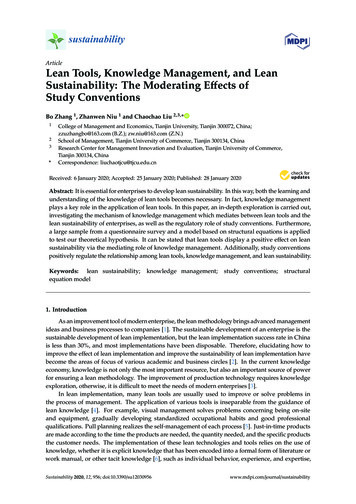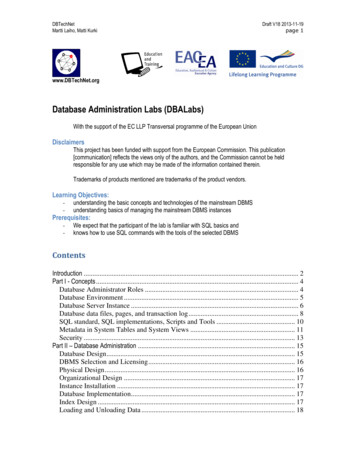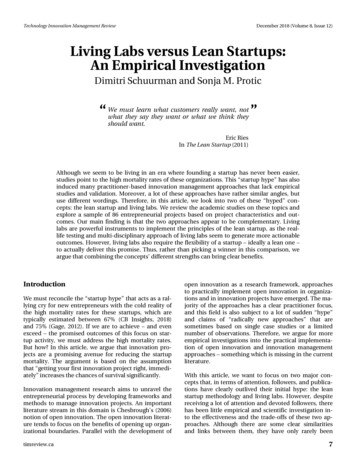
Transcription
Technology Innovation Management ReviewDecember 2018 (Volume 8, Issue 12)Living Labs versus Lean Startups:An Empirical InvestigationDimitri Schuurman and Sonja M. Proticmust learn what customers really want, not ”“ Wewhat they say they want or what we think theyshould want.Eric RiesIn The Lean Startup (2011)Although we seem to be living in an era where founding a startup has never been easier,studies point to the high mortality rates of these organizations. This “startup hype” has alsoinduced many practitioner-based innovation management approaches that lack empiricalstudies and validation. Moreover, a lot of these approaches have rather similar angles, butuse different wordings. Therefore, in this article, we look into two of these “hyped” concepts: the lean startup and living labs. We review the academic studies on these topics andexplore a sample of 86 entrepreneurial projects based on project characteristics and outcomes. Our main finding is that the two approaches appear to be complementary. Livinglabs are powerful instruments to implement the principles of the lean startup, as the reallife testing and multi-disciplinary approach of living labs seem to generate more actionableoutcomes. However, living labs also require the flexibility of a startup – ideally a lean one –to actually deliver this promise. Thus, rather than picking a winner in this comparison, weargue that combining the concepts’ different strengths can bring clear benefits.IntroductionWe must reconcile the “startup hype” that acts as a rallying cry for new entrepreneurs with the cold reality ofthe high mortality rates for these startups, which aretypically estimated between 67% (CB Insights, 2018)and 75% (Gage, 2012). If we are to achieve – and evenexceed – the promised outcomes of this focus on startup activity, we must address the high mortality rates.But how? In this article, we argue that innovation projects are a promising avenue for reducing the startupmortality. The argument is based on the assumptionthat “getting your first innovation project right, immediately” increases the chances of survival significantly.Innovation management research aims to unravel theentrepreneurial process by developing frameworks andmethods to manage innovation projects. An importantliterature stream in this domain is Chesbrough’s (2006)notion of open innovation. The open innovation literature tends to focus on the benefits of opening up organizational boundaries. Parallel with the development oftimreview.caopen innovation as a research framework, approachesto practically implement open innovation in organizations and in innovation projects have emerged. The majority of the approaches has a clear practitioner focus,and this field is also subject to a lot of sudden “hype”and claims of “radically new approaches” that aresometimes based on single case studies or a limitednumber of observations. Therefore, we argue for moreempirical investigations into the practical implementation of open innovation and innovation managementapproaches – something which is missing in the currentliterature.With this article, we want to focus on two major concepts that, in terms of attention, followers, and publications have clearly outlived their initial hype: the leanstartup methodology and living labs. However, despitereceiving a lot of attention and devoted followers, therehas been little empirical and scientific investigation into the effectiveness and the trade-offs of these two approaches. Although there are some clear similaritiesand links between them, they have only rarely been7
Technology Innovation Management ReviewDecember 2018 (Volume 8, Issue 12)Living Labs versus Lean Startups: An Empirical InvestigationDimitri Schuurman and Sonja M. Proticmentioned together in studies or publications. Here, weaddress this gap by first investigating both approachesto identify their similarities and differences. Second, wereport on an empirical investigation of 86 living lab projects in terms of outcomes and project characteristics.Third, we develop propositions regarding the living labversus lean startup approaches and suggest future research to investigate these propositions. Finally, weidentify what lessons can be shared across the two approaches.At the same time, the implied importance of intuitionin the lean startup process is a reason for criticism. Often, the validation of assumptions happens in a rather“quick and dirty” fashion, with rapid iterative cyclesand pivots. Pivots describe strategic changes of business concepts or products: a course correction to test anew hypothesis (Ries, 2008). One study investigatedpivots in the case of 49 software startups and identifiedas many as 10 different types of pivot and various triggering factors (Bajwa et al., 2017).The Lean Startup ConceptRecently, some academic studies have investigated theprinciples and merits of the lean startup in light of leading theories and empirical evidence from current innovation management academic research. For example,York and Danes (2014) looked deeper into the lean startup methodology and linked it with more establishedconcepts from the innovation management literature.They saw the lean startup as a customer developmentmethodology in the broader theoretical context of newproduct development. They regarded customer development as an entrepreneurial practice within the context of earlier product development models such asCooper’s new product development (Cooper 1988,2008) and Koen’s (2004) new concept model for the“fuzzy front-end”. During the essential phase of hypothesis testing, intuition is seen as having a role in theentrepreneurial process, but the entrepreneur is encouraged to collect information and survey the environment in order to make educated guesses (York & Danes,2014).The lean startup is described as a methodology for developing businesses and products that is built upon hypothesis-driven business experimentation, iterativeproduct launches, and validated learning (Ries, 2008;Frederiksen & Brem, 2017). The aim is to shortenproduct development cycles and reduce market risks byavoiding large amounts of initial funding for big productlaunches and subsequent failures. The iterative fine-tuning of the innovation based on validated learning fromearly customer feedback is regarded as the crux of thisapproach. Thus, in the lean startup methodology, the focus is on the formulation of assumptions related to theend user, the validation of those assumptions, and oftentheir subsequent revision (Ries, 2008; Blank, 2006).The lean startup methodology was first proposed by EricRies in 2008 based on personal experiences with hightech startups using his personal experiences adaptinglean management principles to high-tech startup companies, and was later refined into his seminal book TheLean Startup: How Today's Entrepreneurs Use Continuous Innovation to Create Radically Successful Businesses(Ries, 2011). In terms of central ideas and propositions,it is regarded as a follow-up and extension of the customer development idea from Steve Blank’s The FourSteps to the Epiphany (2006). One of Blank’s main pointsis that organizations were focusing too much on actualdelivery and creation of a solution without taking intoaccount consumer demand. Before listening to the customer, these companies spent months or even years perfecting the product without interacting with thecustomer. As a result, many of these innovations failedto reach uptake by the market because the productswere not in sync with actual user needs. This led to anapproach where he proposed “going lean” by basing development on iterative cycles of building, measuring,and learning – a process that is based on the principlesassociated with the terms “failing fast”, “minimum viable product”, “continuous learning”, and “pivoting”.timreview.caThis combination of intuition and more formal processes to reduce uncertainties by iterative and early customer involvement has been advocated by Blank(2006), Maurya (2012), and Cooper and Vlaskovits(2010). York and Danes (2014) summarize the customerdevelopment model in four stages: 1) customer discovery: a focus on understanding customer problems andneeds, where the goal is to establish a problem–solution fit and develop a minimum viable product (MVP);2) customer validation: the identification of a scalableand repeatable sales model, where the goal is to establish product–market fit and find a viable business model; 3) customer creation: creating and driving end-userdemand; and 4) company building: the transition of theorganization from learning and discovery to efficient execution. Stage 1 already includes challenging all assumptions, whereas the product should be launched assoon as possible (i.e., as an MVP) to increase the level offeedback. Subsequently, the lean startup methodologyitself can be understood as a set of tools originating8
Technology Innovation Management ReviewDecember 2018 (Volume 8, Issue 12)Living Labs versus Lean Startups: An Empirical InvestigationDimitri Schuurman and Sonja M. Proticfrom different business development methods. The actof hypothesis testing with potential customers is referred to as “getting out of the building” by Blank (2006),but although the wording implies doing this “outside”or in “real-life”, this actually simply refers to talking tocustomers, users, and experts.Although a large number of incubators and entrepreneurship programmes apply the lean startup methodology, there is still a lack of knowledge regarding itsimplementation in the real world (Mansoori, 2017).Based on interviews with 11 Swedish technology startups in the setting of a prescriptive accelerator programme, Mansoori (2017) describes vicarious andexperimental learning as a means for entrepreneurs toacquire and apply lean startup theory in practice. Anempirical approach is also provided by Edison and coauthors (2018), who analyzed different case studies to investigate the use of the lean startup methodology to facilitate software product innovation in large companies.They identified a list of key enablers for success, such asautonomy in decision-making processes or top management support, and inhibitors, often found in complexand bureaucratic business structures that slow down development processes. Finally, a study by Ladd (2016)looked into 250 innovation teams from a cleantech accelerator programme and found out that, in general, thelean startup methodology seemed effective: teams thattested hypotheses about their venture performed almostthree times better in a pitch competition (a proxy forsuccess) than teams that did not test any hypotheses.However, the number of validated hypotheses did notshow a linear correlation with the success of theseteams, which indicates that too much testing can alsobe detrimental for startup development. Ladd (2016)identified a loss of confidence and too many changes aspossible explanations of these results. A recent study byFrederiksen and Brem (2017) investigated the scientificliterature in search of antecedents and empirical evidence for the main principles of the lean startup methodology. Their results indicate that, overall, the methodsfind considerable backing and can be recognized, atleast in part, under already established constructs.Heavy use of effectuation logic is evident throughoutRies’ (2011) book, with a clear and explicit emphasis onexperimentation over long-term planning, but the mainelements and propositions of the lean startup can be atleast partly supported by academic research.Whereas the lean theory is often associated with technology-driven sectors, the methodology is already used inother sectors such as healthcare and communication(Silva et al., 2013). Looking at the ownership structure oftimreview.calean startups, we mostly see clear management structures that are either team-driven or company-driven,but the scientific literature generally does not elaborateon different stakeholder participation in detail. Nevertheless, Kullmar and Lallerstedt (2017) elaborated onthe advantages and limitations of the lean startup approach from the perspective of three different stakeholders: entrepreneurs, business developers, and investors.Although close customer collaboration was consideredcrucial, the findings also indicated that, when dealingwith radical innovation, customer feedback might evenbe counterproductive for entrepreneurs, as customerstend to focus on the delightful and frustrating aspects ofthe current offering, whereas radical innovation taps into more latent needs (Thiel & Masters, 2014).In summary, there is some academic literature that supports the claims of the lean startup methodology, although the evidence is not conclusive. Moreover, themajority of the publications on the lean startup methodology do not include empirical data, but rather rely onspectacular but anecdotal “cases”.The Living Lab ConceptThe concept of the living lab evolved from the notion oflong-term field experiments in the 1980s and 1990s, tolab infrastructures aimed at testing innovations in settings aimed at recreating real-life conditions in the1990s and 2000s, towards an innovation approach basedon user co-creation and real-life experimentation in the2000s and 2010s. Living labs are regarded as complexphenomena where three analytical levels can be distinguished: the organizational level, the project level, andthe individual user interactions level (Schuurman,2015). The living labs literature is very explicative interms of the participating stakeholders and actors involved. This is apparent at the organizational level (e.g.,Leminen, 2013; Leminen et al., 2012) or at the user interactions level (e.g., Dell'Era & Landoni, 2014; Leminen etal., 2014). For this article, we focus on the project level,which is the least discussed level in the living labs literature, as a systematic literature review revealed (Schuurman, 2015).A living lab project approach is described as a structuredapproach to open innovation and user innovation(Almirall & Wareham, 2008; Leminen et al., 2012;Schuurman et al., 2016a). Thus, we look at living lab projects from an innovation management perspective.Common elements of living labs are: 1) co-creation, 2) amulti-method approach, 3) multi-stakeholder participation, 4) a real-life setting, and 5) active user involvement9
Technology Innovation Management ReviewDecember 2018 (Volume 8, Issue 12)Living Labs versus Lean Startups: An Empirical InvestigationDimitri Schuurman and Sonja M. Protic(ENoLL, 2018). In terms of methodology, most papersfocus on these specific elements without going into further detail about how these elements are combined orlinked in a specific methodology. The most concreteare the works of Pierson and Lievens (2005) andSchuurman and colleagues (2016a), who put forward aquasi-experimental design that includes a pre-test, anintervention, and a post-test. This quasi-experimentaldesign – with the elements real-life experimentation,active user co-creation, and a multi-method approach– generates creative tension, according to Almirall andWareham (2011), where user-led insights are cultivatedand tacit, experiential, and domain-based knowledge issurfaced, codified, and communicated.A key defining aspect of living labs is the real-life context, which allows the dynamics of everyday life to playa vital role in innovation processes. It includes both aregional aspect, such as pushing product tests or needsassessment in cities, rural areas, and real or virtual networks, and an everyday life context in terms of actualuser involvement. The lab is anything but a solitary environment. Living labs use multiple methods such asqualitative and explorative research approaches, including, for example, ethnographic methods, co-creation sessions, field tests, and idea scouting. Again, theoverall goal is to ensure a continuous, content-basedinteraction between the lab and its customers. The cocreation aspect and the active user involvement of living labs require strong cooperation and openness n in real-world circumstances is a defining characteristic of living labs. Nevertheless, the literature fails to acknowledge exactly why this is the caseand how it should be realized. It is the “dynamics ofeveryday life” that are put forward as a reason for nothaving a systematic or structured approach within living labs. At the same time, multi-stakeholder involvement is a central issue, and a lot of research concernsactor roles in living labs (e.g., Nyström et al., 2014;Schuurman et al., 2016b). In terms of the living lab actors, this task is carried out by the living lab researchers,who engage in a dual role of action researcher as theysolve immediate problems while informing (living labs)theory (Logghe & Schuurman, 2017; Ståhlbröst, 2008).Multiple roles lead to divergent interests and an increasing complexity in decision making. However, wedo not see these reasons as arguments for not following a clear structure and decision-making process. Especially when looking at the ownership and thebusiness model of living labs, we observe a lack of clarity (Protic & Schuurman, 2018).timreview.caThe five elements of living labs lead to the assumptionthat they are able to generate tacit and experientialknowledge that is not obtained in “traditional” innovation approaches. That is why the codifying and communicating suggests that translation of these insights iscrucial. In general, we see a great variety of strategies forrevenue generation among living labs (Protic & Schuurman, 2018). While some are active in the early stage ofinnovation processes, others are more likely to serve astest beds or urban development instruments. As Ståhlbröst (2013) describes, labs also offer predefined, feebased services to their clients (i.e., the “living lab as aservice”). In general, these labs tend to have clearermanagement and ownership structures, as daily operation is very similar to service-driven organizations. Wecan refer to iMinds Living Labs (now called imec.livinglabs: www.imec-int.com/en/livinglabs) as an example, asthis organization within a larger research institute developed into a service-driven organization after the experience of being part of three funded consortium livinglabs (see Schuurman, 2015 for a detailed descriptionand analysis). In this living lab as a service organization,projects are carried out for “customers” of the living laband thus have a clear project owner, whereas in consortium-based living labs, ownership and roles in living labprojects tends to be less clear because of the diverginginterests of the consortium partners (Schuurman et al.,2016b).There are few studies that present concrete results ofthe outcomes of these living lab projects, and even fewer that compare living lab projects with other innovation projects. Ståhlbröst (2012) puts forward fiveprinciples that should guide the assessment of a livinglab’s impact. In a follow-up study, Ståhlbröst (2013) assesses these principles in a qualitative way for five micro-enterprises. Nevertheless, the results are rather anapplication of the principles than an actual impact assessment. Schaffers and colleagues (2012) reported onthe results of a European project in which cross-borderliving lab activities led to new business opportunitiesand increased revenue, but the sample is also limited.Schuurman and colleagues (2016a) compared 13 projects with a full living lab methodology with 14 projectswithout a full living lab methodology. The main findingsare that the living lab projects seem to foster more actionable user contributions than non-living-lab projects, but that the non-living-lab projects seem toadvance faster when going to market, aborting a go-tomarket attempt, rebooting with a new innovation project etc., whereas more living lab projects remain in the“in development” stage. Ballon and colleagues (2018)10
Technology Innovation Management ReviewDecember 2018 (Volume 8, Issue 12)Living Labs versus Lean Startups: An Empirical InvestigationDimitri Schuurman and Sonja M. Proticprovide the most comprehensive study into impact assessment for living labs and come to the conclusion thatimpact assessment is difficult and poses severe methodological barriers to be overcome. The paper itself also reports an impact assessment of a sample of living labprojects, focusing on the economic impacts. This studyalso suggests the added value of a living lab approachand proposes that, although it is difficult to clearly assess impact, this does not mean that no attempts shouldbe made to do it. In this article, we want to assist infilling this gap in research into living labs, open innovation, and user innovation by looking into a larger sampleof innovation projects and juxtaposing the findings withthe theoretical considerations of both living labs and thelean startup methodology.MethodologyIn the current study, we adopt a mixed design withquantitative and qualitative data. For the quantitativepart, we look at all innovation projects carried out by theuser research team of imec.livinglabs (previously iMindsLiving Labs and iLab.o) from 2011 up to 2018, whichmakes for a sample of 86 projects. This means all of theprojects in our sample are linked to a living lab organization, so we cannot make a comparison with projects thatadopted a lean startup methodology. However, the datafrom this sample allows for the investigation of certainelements of the living lab methodology, which will becontrasted with the lean startup literature in the discussion.For this sample, we coded the presence of a real-life fieldtrial in the projects based on the project deliverables. Wealso coded the status of the project in terms of projectoutcome: “on the market” if the innovation is availablefor adoption by end users, “abort” if the innovation project is stopped and the team members disband, “reboot”if the innovation project is stopped but the team members continue with a new innovation project based onthe insights, and “in development” to indicate that theinnovation had not yet been launched. This last categorycan be regarded as an “in-between state”: over time,these projects will either become available on the market, be aborted, or be rebooted. The data for the initialcoding of the projects was taken from a post-assessmentinterview at the end of each project. However, every yearthis database is updated based on an online search anda personal follow-up with the project owners to assesschanges. The last update of the status dates from May2018. All of these projects were innovations with a digitalcomponent. The majority (58) had a business-to-consumer (B2C) focus, whereas the remaining 28 projectstimreview.cacould be labelled as business-to-business (B2B). For anidea of some of the projects, see Schuurman (2015) andSchuurman and colleagues (2016a).For the quantitative analysis, we simply compared thenumbers of the projects with a real-life field trial, whichcan be considered as living lab projects, with thosewithout a real-life field trial (see Table 1). Because ofthe relatively small sample size as compared to the outcome categories, no chi-square tests could be performed as the expected cell numbers were less than 5for more than 20% of the cells. Therefore, here, wesimply report the percentages. For the qualitativestudy, we selected cases from each category (abort, reboot, in development, and on the market) and lookedfor further evidence related to our literature review.ResultsThe main results from the quantitative analysis for the86 projects are summarized in Table 1. Overall, roughly1 out of every 4 projects was stopped after the projectand almost 1 out of 10 was rebooted based on the project insights, whereas 1 out of 10 are still in development or implementing the lessons learned.In this sample of 86 projects, another striking findingbecomes apparent. Overall, only a minority (42%) of allprojects can be regarded as “real” living lab projects,meaning they contained a proper real-life field trial.These “innovation projects” that lacked a real-life trialwere, for example, projects in which testing only tookplace in a laboratory setting (15 projects) or where userideation or co-creation took place without an intervention with (i.e., a prototype of) the innovation (33 projects). This can also be explained by the fact that,already in these exploratory stages, the absence of amarket need was detected, which was the case for 1 outof 5 of these projects (see also Schuurman et al., 2016a).However, in general, the majority of the projects resulted in the original innovation idea – the one under investigation at the start of the project – being launchedon the market at some point. Just over half of the livinglab projects with a real-life trial resulted in a marketlaunch, but even 60% of the “innovation projects” alsoended up in a market launch. It can be assumed thatthese entrepreneurs engaged in an innovation projectwith the living lab organization and either took the “exploratory” learnings from this innovation project to develop a prototype and did the testing themselves orthey relied on their intuition and simply launched oraborted the project. However, more investigationwould be needed to confirm these assumptions.11
Technology Innovation Management ReviewDecember 2018 (Volume 8, Issue 12)Living Labs versus Lean Startups: An Empirical InvestigationDimitri Schuurman and Sonja M. ProticTable 1. Comparison of the outcome of projects with and without real-life trialThe biggest difference between the living lab versus innovation projects is the fact that the majority of all “reboots” occurs in projects with a real-life field trial. Thepercentage of market launches is slightly lower, and thepercentage of “aborted” projects is higher. This seemsto support the fact that real-life experimenting indeedsurfaces tacit needs. This would allow a decision onwhether to continue (and pursue a market launch), orto abort. Moreover, the relatively high number of reboots supports this tacit user need these, as novel tacitneeds surface and elicit novel innovation ideas.However, because of the small number of reboot projects, this is again an assumption that needs further validation.Therefore, to look for further evidence, we performed asmall qualitative investigation into the five projects thatincluded a reboot after a living lab project with a fieldtrial. The data from these projects was gathered fromthe project proposals, the project deliverables, meetingnotes and data from a post-assessment survey. Ourfindings are summarized below:1. InCitys: This project investigated the potential of asmart city platform for citizens. However, based on atest in a Flemish city, there was low interest from citizens as well as from other actors that would providecontent on the platform. However, one use case, inthe domain of smart energy, was relatively successful. Based on this finding, the collaboration with theenergy provider was intensified and this resulted in a“smart plug” offering being launched on the market.2. Wadify: The objective of this project was to create anonline video platform for young people, who wouldbe rewarded for watching advertisements. For theyoung people, the test was very successful, as theyliked the platform very much and showed interest intimreview.causing it in the future, but the interest from advertisers was too low. However, based on the discussionswith the young people and research into their interests, the entrepreneurs made the connectionbetween festivals and smart technologies. This resulted in Playpass, a new direction of the team behindWadify that focused on smart wristbands for festivals. In this area, they have successfully launchedtheir first product.3. Nazka: This project dealt with the visualization of airquality metrics on maps. During the field trial, theuser feedback indicated that the numbers were hardto interpret and that end users were not that interested in this data. This made the company shift froma business-to-consumer (B2C) model towards a business-to-business (B2B) model where they providedthe basic infrastructure and opened up their datasetsto allow other parties to re-use the data and makesense of it. In this new B2B model, they adopt a licensed-platform approach and no longer interact directly with the end user.4. Veltion: This B2B startup advised companies on theoptimization of production and other company processes. They developed an application that could beused by workers to report issues and suggest improvements. Within the living lab test, the application was tested and the experiences of twocompanies were positive and satisfying. However, interviews with the company managers also revealedthat this usage would cannibalize their regular service offering, as it would potentially replace their consulting business. The positive field trial paired withthese insights made them change their initial idea,and they now use an adapted form of the applicationas an “add-on” to their consulting business ratherthan a standalone offering.12
Technology Innovation Management ReviewDecember 2018 (Volume 8, Issue 12)Living Labs versus Lean Startups: An Empirical InvestigationDimitri Schuurman and Sonja M. Protic5. Planza: This planning tool was initially oriented as aconsumer service. The field trial revealed a positiveuser experience, but indicated a lack of “willingnessto pay”. Thus, the original idea behind Planza wasdeemed not viable, and the team shifted towards aB2B approach. The platform was stripped to keep thefunctionalities that were of interest in a B2B-setting,and the result was a planning tool for companies.The above examples indicate that putting the innovation to the test in a proper real-life field trial helps theprojects validate critical assumptions and take key decisions regarding the next steps in their innovation development process. One finding that can be abstract
The lean startup methodology was first proposed by Eric Ries in 2008 based on personal experiences with high-tech startups using his personal experiences adapting lean management principles to high-tech startup com-panies, and was later refined into his seminal book The Lean Sta
